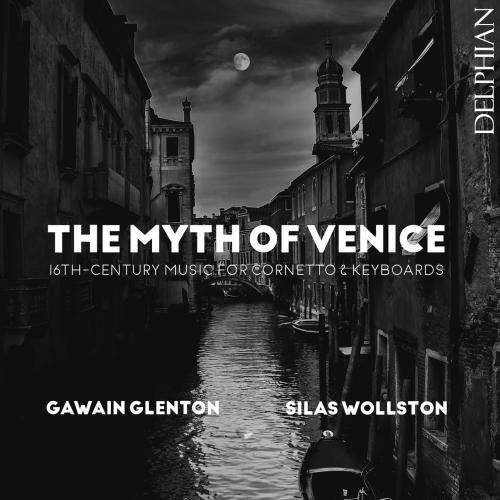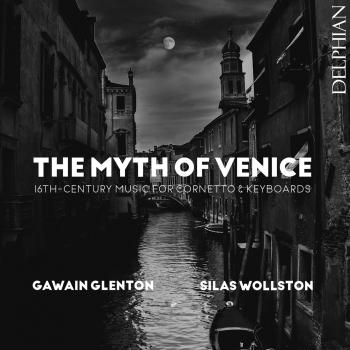
The Myth of Venice: 16th-Century Music for Cornetto & Keyboards Gawain Glenton & Silas Wollston
Album Info
Album Veröffentlichung:
2021
HRA-Veröffentlichung:
22.10.2021
Label: Delphian Records
Genre: Classical
Subgenre: Chamber Music
Interpret: Gawain Glenton & Silas Wollston
Komponist: Andrea Gabrieli (1510-1586), Adrian Willaert (1490-1562), Giulio Segni (1498-1561), Girolamo Parabosco (1524-1557), Annibale Padovano (1527-1575), Claudio Merulo (1533-1604), Girolamo Diruta (1560-1630), Vincenzo Bellavere (1540-1587), Claude Gervaise (1510-1558), Giacomo Gorzanis (1520-1579)
Das Album enthält Albumcover Booklet (PDF)
- Andrea Gabrieli (1533 - 1585):
- 1 Gabrieli: Ricercar del XII tuono 02:52
- Adrian Willaert (1490 - 1562):
- 2 Willaert: Jouissance vous donneray (diminutions by Girolamo Dalla Casa) 04:09
- Giulio Segni da Modena (1496 - 1561):
- 3 Modena: Ricercar 13 01:51
- Girolamo Parabosco (1524 - 1577):
- 4 Parabosco: Ricercar 14 ‘Da pacem Domine’ 02:01
- Annibale Padovano (1527 - 1575):
- 5 Padovano: Ricercar del VI tuono 05:06
- Andrea Gabrieli:
- 6 Gabrieli: Pass’e mezzo antico 03:45
- Adrian Willaert:
- 7 Willaert: A la fontaine (diminutions by Giovanni Bassano) 05:46
- Giulio Segni da Modena:
- 8 Modena: Ricercar 5 02:07
- Claudio Merulo (1533 - 1604):
- 9 Merulo: Toccata 8 06:01
- Girolamo Diruta (1554 - 1610):
- 10 Diruta: Ricercar a 4 03:33
- Andrea Gabrieli:
- 11 Gabrieli: Caro dolce ben mio (diminutions by Giovanni Bassano) 03:06
- Vincenzo Bellavere (1540 - 1587):
- 12 Bellavere : Toccata per organo 03:16
- Girolamo Diruta:
- 13 Diruta: Toccata di salto cativo del VI tuono 02:17
- Claude Gervaise (1525 - 1583):
- 14 Gervaise: Pavane ‘La venissiene’ 01:57
- Giovanni Pierluigi da Palestrina (1525 - 1594):
- 15 Palestrina: Introduxit me rex 03:45
- Gioseffo Guami (1542 - 1611):
- 16 Guami: Toccata del II tuono 01:51
- Anonymous:
- 17 Anon.: El todescho 01:03
- Giacamo Gorzanis (1520 - 1575):
- 18 Gorzanis: Il todeschino 02:08
- 19 Gorzanis: Padoana del todeschino 02:01
- Gioseffo Guami:
- 20 Guami: La brillantina 03:01
Info zu The Myth of Venice: 16th-Century Music for Cornetto & Keyboards
With the arrival of Adrian Willaert at St Mark’s Cathedral in 1527, Venice at last boasted a musician of international reputation to match its growing image as a ‘city rich in gold but richer in renown, mighty in works but mightier in virtue’. The establishment of Venice as the world leader in music publishing, and the coming and going of international musicians, made the Floating City anything but insular, and artistic competition was order of the day, with organists duelling to outdo each other in invention and grace; while on the streets a different culture of lively dances gave rise to more opportunities for instrumentalists to show off their improvisational skills.
Intimate yet exuberant, scholarly yet unrestrained, Gawain Glenton and Silas Wollston’s exploration of the often dazzlingly virtuosic repertoire shows how the enduring ‘myth of Venice’ was built in sound just as much as it was in marble.
Gawain and Silas have been playing together for several years as part of ensembles such as The English Cornett & Sackbut Ensemble, In Echo, The Bach Players and the Taverner Consort. Recently we started giving recitals with the aim of pairing the cornetto with historical organs. The success of these recitals has made us want to do more, so we're thrilled that Delphian Records have agreed to record this new venture. For this recording we are focussing on music from 16th-century Venice, specifically the period between Willaert's arrival in the city in 1527 and the end of the century. These decades were arguably the most vibrant of Venice's musical history, and it was then that the musical 'myth of Venice' was built in sound thanks to the compositions and virtuosic performances of composer/musicians such as Giovanni Bassano, Girolamo Dalla Casa, Gioseffo Guami, Andrea Gabrieli, Claudio Merulo, Parabosco, Padovano, Segni and others.
We're based in England and are working within the restrictions of COVID-19, so we aren't able to easily hop on a plane to record in the Veneto. However, we do have access to two very special organs based here in the UK. One is the Goetze & Gwynn reconstruction of the Italian chamber organ that formerly belonged to Sheila Lawrence and now resides in the English Organ School in Milborne Port, Somerset. This compact but powerful instrument has the distinctive metal principale and range of stops typical of Italian renaissance organs. We are very lucky to have it in the UK.
The second organ is made by the Italian maker Walter Chinaglia, and features open wooden 8ft and 4ft registers in cypress: the particular wood praised by Italians in the sixteenth and seventeenth centuries as being able to produce an 'organo suave', the sweet-sounding organ ideal for the accompaniment of the human voice. According to Dalla Casa and others, the cornetto famously had the ability to imitate the human voice better than any other instrument, and much of its repertoire is in fact vocal music. So, what better way to accompany a 'singing' cornetto than a cypress 'organo di legno'? (NB: If you want to know why we're going to the trouble of using these organs rather than the ubiquitous stopped box chamber organ, check out this explanation by the wonderful Elam Rotem at Early Music Sources).
Gawain Glenton, cornetto
Silas Wollston, organ
Gawain Glenton
Gawain's work as a soloist and an ensemble musician takes him all over the world. He performs and records with many leading international groups and directors, such as Il Giardino Armonico, l'Arpeggiata, Concerto Copenhagen, Les Talens Lyriques, Concerto Italiano, Barokksolistene and the Nederlandse Bachvereniging. Gawain is a member and co-director of The English Cornett & Sackbut Ensemble, with whom he has recorded several acclaimed CDs, including 'The Spy's Choirbook' with Alamire - winner of the 2015 Gramophone Award for Early Music. Gawain is the founder/director of In Echo, whose debut CD 'Music in a Cold Climate' (Delphian) received stellar reviews and broke into the top-10 of the UK classical charts.
Now based in the UK, Gawain spent several years living in Basel where he studied with Bruce Dickey at the Schola Cantorum Basiliensis. As a result of these years abroad, Gawain is closely involved with ensembles such as Ensemble Leones and the Basel-based I Fedeli. In the UK, Gawain also works with ensembles such as Arcangelo, Fretwork, The Illyria Consort, The Dunedin Consort, The Taverner Consort, La Nuova Musica and I Fagiolini.
Gawain's research and expertise in the field of ornamentation has also led to him becoming increasingly in demand as a coach for both singers and instrumentalists. His experience as a professional singer and multi-instrumentalist also helps to make him a highly versatile musician. Very much at home in the rich musical world of the 16th and 17th centuries, Gawain also enjoys expanding the repertoire of the cornetto, either by performing new and challenging contemporary music, or by working with other musicians from the rock, pop and folk worlds.
Gawain is working towards a doctoral study of Italian diminution treatises at Southampton University (funded by the AHRC as part of the South West & Wales Doctoral Training Partnership).
Silas Wollston
Recognised as a leading early music specialist, Silas Wollston has combined performance and scholarship in a varied career. A longstanding member of the English Baroque Soloists and The Bach Players, he performs on harpsichord and organ with early music orchestras and ensembles, as well as in duo partnerships and as a soloist. A former chorister, he studied the organ with John Scott before taking up an organ scholarship at Trinity College, Cambridge. He then went on to study harpsichord and early piano at the Guildhall School of Music and Drama and the Conservatoire Royale in Brussels.
Beyond his career a performer on keyboard instruments, Silas also has much experience as a choral director and an academic lecturer. As Director of Music at Queens’ College, Cambridge, between 2011and 2015, he greatly enhanced the profile and reputation of the choir, issuing recordings with Orchid Classics. He is now part of the choral directing team at the Royal School of Church Music. He lectures in fugue and stylistic composition at Cambridge University and is a council member of the Handel Institute. His research interests include 17th-century violin-band music, especially the music of Matthew Locke, and Handel's compositional process.
Booklet für The Myth of Venice: 16th-Century Music for Cornetto & Keyboards










